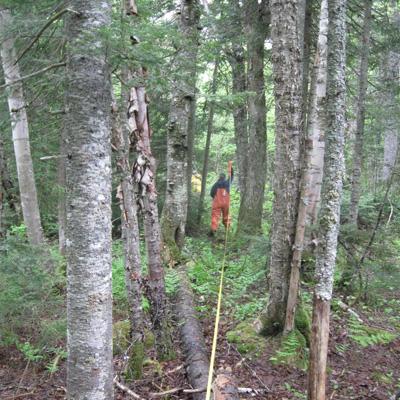Late-Successional and Old-Growth Forest Carbon Temporal Dynamics in the Northern Forest (Northeastern USA)

A key challenge in using forests for carbon storage and climate change mitigation is having accurate data and forest computer models for estimating carbon fluxes (movement through an ecosystem) under different forest management scenarios. Most assessments use growth and yield models, such as the USDA Forest Service Forest Vegetation Simulator (FVS), to predict management impacts on carbon stocks (trees and logs). FVS was developed without data from late-successional and old-growth (LSOG) forest age classes and may underestimate their capacity to accumulate carbon. NSRC researchers assessed aboveground carbon stocks in LSOG forests and the ability of FVS to predict those carbon stocks.
Researchers re-measured standing live and dead trees and downed woody material on 65 plots in LSOG stands in northern Maine which had been measured about ten years earlier. Late-successional (LS) and old-growth (OG) aboveground live carbon stocks were 2.4-2.6 times greater than average forest carbon stocks for the region. LS aboveground live carbon stocks accumulated an average of 0.61 megagrams/ha annually, while OG aboveground live carbon stocks lost an average of -0.54 megagrams/ha annually. OG stock declines were driven by the mortality of large American beech trees from beech bark disease, likely exacerbated by drought. Northeastern LSOG stands may be important for climate change mitigation because their carbon stocks (per hectare) are very large, but trees are vulnerable to exotic species and weather events.
The Northeast Variant of FVS did not reliably predict aboveground, live-carbon accumulation rates in northeastern LSOG stands. Regional forest carbon models need to be re-calibrated if they are to accurately predict carbon accumulation in LSOG stands.
